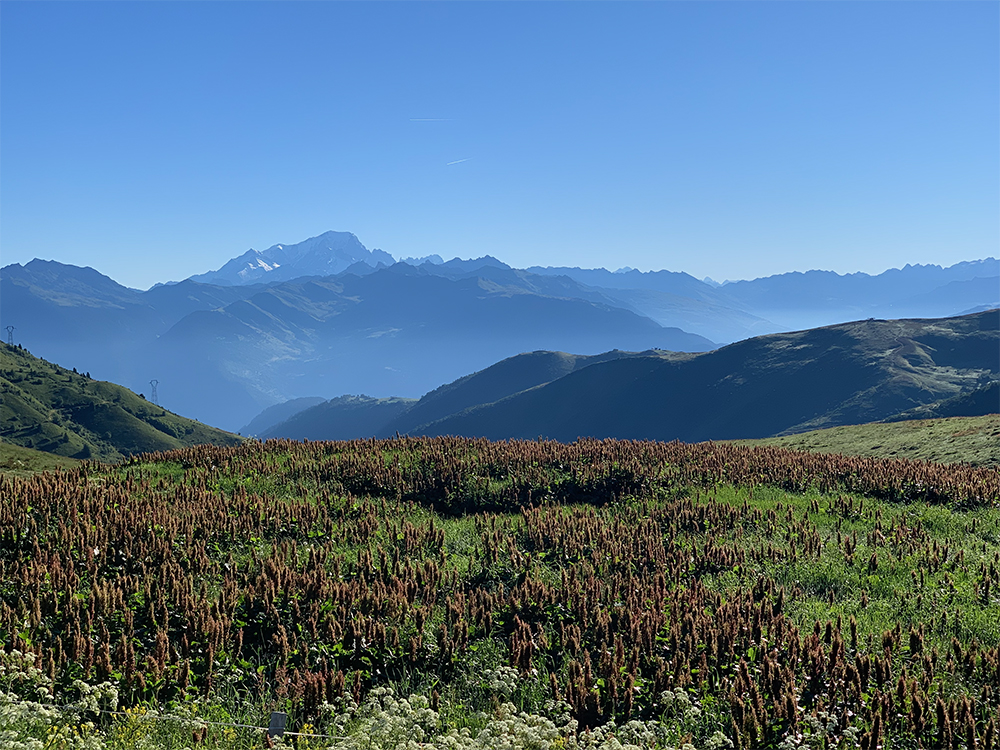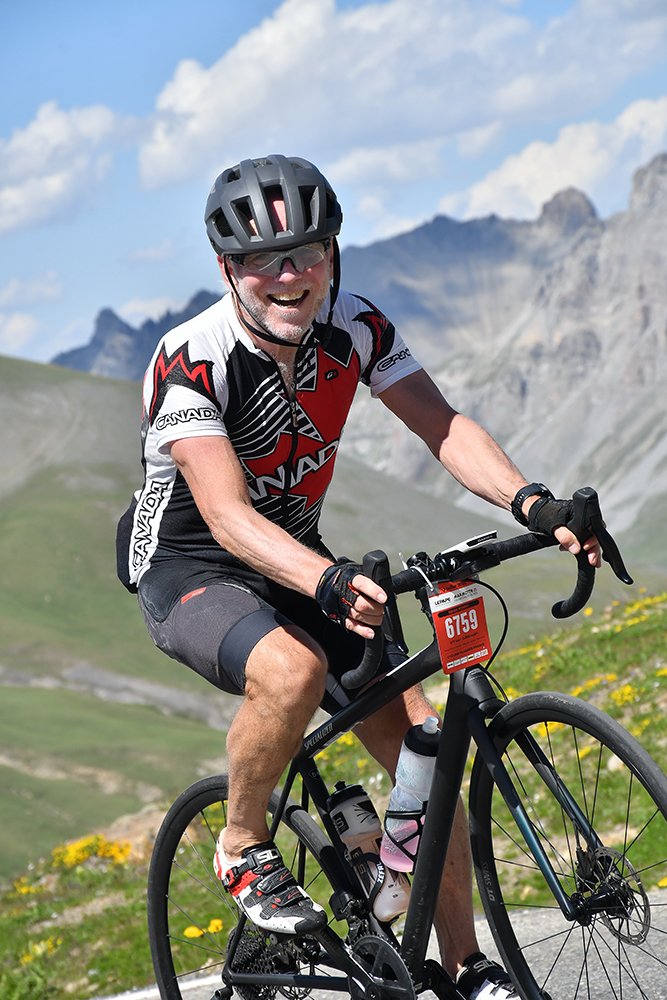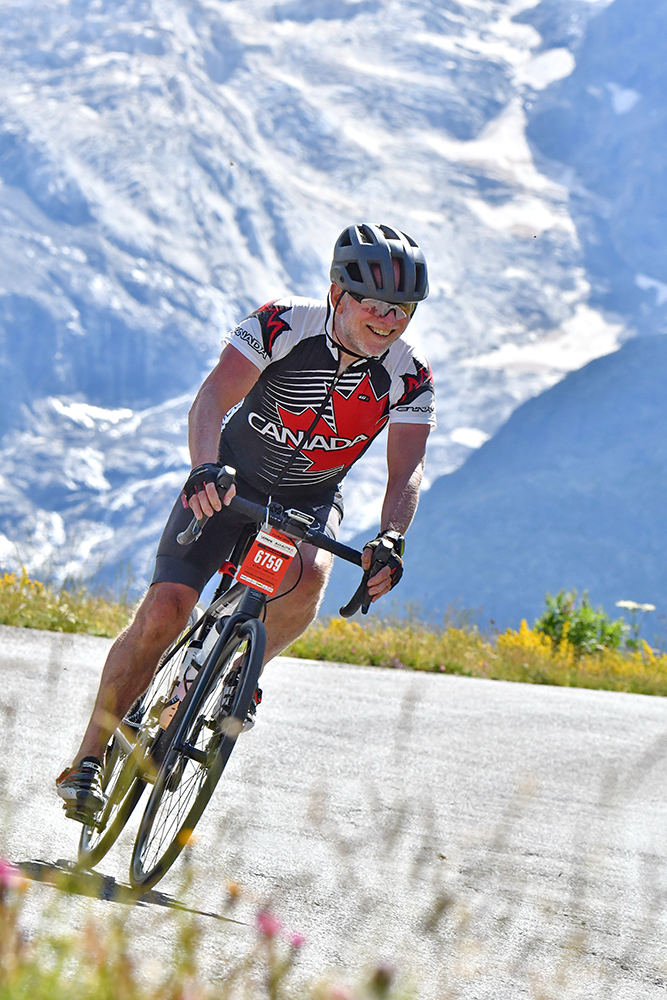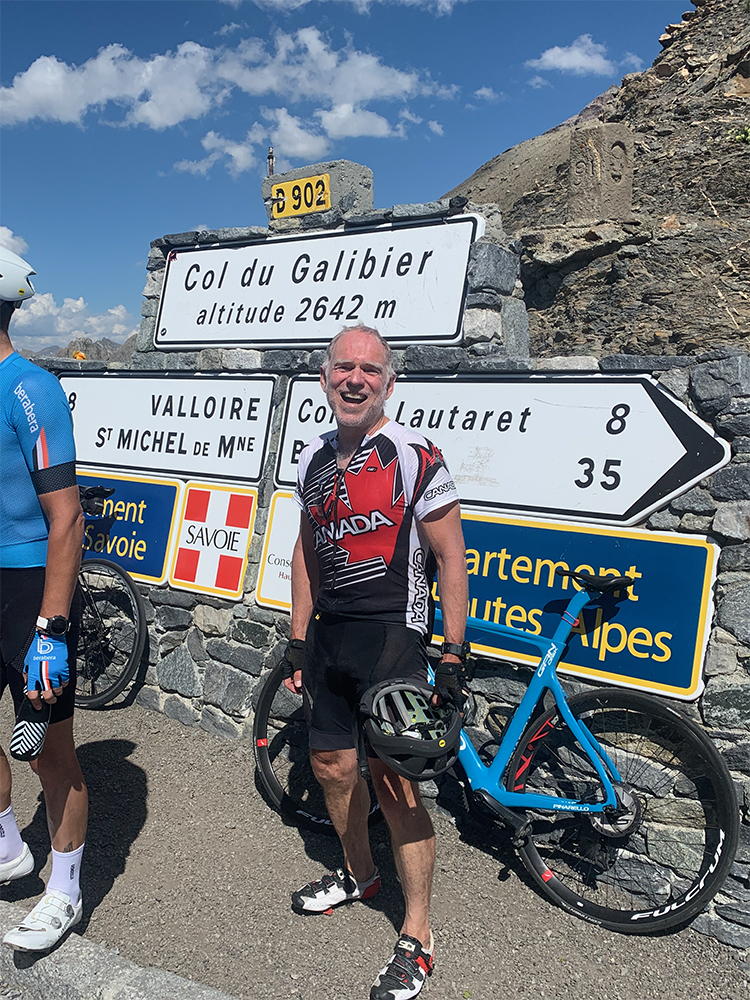I will explain the excessively long title towards the end of this piece. For now, straight into the detail.
In November 2021 I signed up for another big bike ride, the Marmotte Grandfondo Alpes. I did it in 2019 with BW and AS, my first-ever such big event. It is 175km with 5,000m of climb, and covers some of the classic Tour de France cols: The Glandon, Télégraphe, Galibier, and finishes with the Alpe d’Huez climb. Race date was 3 July, 2022.
This summer has had some great weather, and the same was predicted for the race weekend. Friday I dropped Mister Snagsby, the dog, off at the kennel and by 06:30 Saturday morning, I was on the road. I took an over-mountain route, traversing the Col de Madeleine and then over the Col du Glandon, which in fact covered part of the route of the Marmotte, albeit in the reverse direction. So I was able to reconnoiter, look for sharp turns and bad road surfaces.
It was only then it occurred to me that I’d missed a trick: if I had bought a can of spray paint on Friday, I could have stopped at strategic points and painted “Go, Brad, Go!” along the route for the next day’s event. Sort of self-encouragement. When you have a fanbase of one, and that one is you, you have to improvise…
The views from the two cols were stunning. From the Madeleine it is actually possible to see the Matterhorn, distant, but unmistakable.

I arrived in Alpe d’Huez at noon, was in bed by 20:00, and, as is typical of these things for me, was wide awake at 04:00. So I got up very early, and headed down on my bike, via the 21 hairpin bends of the famous Alpe d’Huez climb. All being well, I’d repeat the effort, in the reverse direction, in 10 – 14 hours.
There were three starting paddocks, and riders were assigned to them according to their own estimated time to complete. I was in the slowest group, the last group to depart, and I was first one into the paddock. But it soon began to fill up.
It is an interesting situation: people from diverse nations, ages, morphologies, backgrounds, all thrown into the same situation, all thinking very similar thoughts, all looking full of nervous anticipation. And I was no different: I was worried, and just wanted to be off, settled into the saddle, tuning the legs. My calves felt like bags of electric mice. Eventually the security guy, on motorcycle, lead us to our place in the main town square. Someone important – the mayor, I don’t know — gave a little speech, they counted down from 10, and at last we were off.
The first bit is pretty flat, we were all bunched together, all moving at approximately the same speed (a bit fast for my liking, being in a crowd), but eventually we spread out, and I found a group going at a speed that suited my target power output.
My whole race strategy was based on power. I wanted to keep below 200W wherever possible, as I believe, for me, this is the pace that best conserves glycogen. In some situations, you just have to go higher: once the slope passes a certain steepness, you run out of gears and if you don’t pedal hard, you fall off. Well, I do, anyway.
The other component of the strategy was “steady as she goes”. I wanted my power output to be as stable as I could possibly make it.
The flat ends in Allemond, where the Eléctricité de France (EDF) have created a dam and power generators, called Lac du Verney. The first slope is in fact switchbacks built right into the face of the dam itself. The lake is beautiful, but there wasn’t much time to take in the views, as the road follows the lakeside, is flat, I was in a tight group, and we were moving at pace. Eventually we reached the end of the lake, and turned off, starting the the first big climb to the Col du Glandon.
Glandon is a long haul. Towards the beginning there are some ups and downs, with the transition between the two often quite abrupt. You can be sailing along in descent at speed, bottom out, and if you are not prepared, need to shift through your whole range of gears in about 20 metres. I almost fell off when I did this in 2019; second time ready, I almost fell afoul of others who had not anticipated the change.
Out of the forest, the climb becomes more regular, which is to my advantage, because my forté is steady going. There is another dam and large lake at around 2000 meters, just after the trees suddenly disappear, and the austere mountains come into view. I passed a Red Cross van attending to a rider, down. They were attaching ECG sensors to his chest, so I guess we were not talking cycling accident.

There is a feeding station at the top of the Glandon, and it was chaos: there is not a lot of space up there, as it was early in the race we were all still bunched together, some riders elected to queue up while still holding their bikes which made for traffic jams galore, and it was almost impossible to move about; certainly continuing to ride through was out of the question.
But I had already formulated my strategy, based on my previous Marmotte. I would skip this feeding station entirely, and walking, passed through the crowds as quickly as I could, found an open patch of tarmac, and suddenly was descending at high speed.
The route down is spectacular. An early series of closely-spaced, tight hairpins gives way to long, very fast, straightish stretches followed by gentle bends or tight hairpins. Once you get into the forest, these turns are blind, so you remain in doubt as to how much you need to slow down. But I had switched my cycling computer over to map mode, which provides a map of the road ahead. As this part of the route had been closed to traffic, you could be reasonably certain the only upcoming obstacles were heading downhill: your fellow, slower riders. It is rare to be able to descend at such speed with such confidence. It scared me, but I loved it. And felt like I’d saved a lot of time.
Eventually, the route bottomed out, we were in the Maurienne, and so on the (approximately) only long flat bit of the whole course. I found a group once again whose speed met my power requirements, and we made blistering time for the effort involved. That lasted for a good 45 minutes. But I had not yet taken on fuel, and was starting to feel the effects. A big climb was coming up. What to do?
Given the Glandon feeding station was chaos last time, this time around I had done my homework: on the internet I had found a boulangerie in Saint Michel de Maurienne, which was on the route, and had called them a few days before to check opening hours. They were good all day Sunday. I was in and out in 2 minutes, a chicken salad sandwich and Orangina in hand. Not particularly high-tech food, but it fuelled the climb that was to come.
The boulangerie was not much more than 500 metres from the turn-off that headed up towards the Col du Télégraphe, the next big landmark on the route. In the valley, the temperature had hit 36ºC, but we were moving at speed so there was a breeze; the climb to the Glandon had been done in cool temperatures; the descent and traverse under minimal to moderate effort. Suddenly, we had to climb in the intense heat.
Almost all the way up to the Télégraphe, the route is in forest, but that only means sometimes you are in sun, sometimes shade, and mostly you don’t get to decide which. This was the first time I saw people starting to fall away: groups at the side of the road, either looking uniformly tired, or attending to a team mate, who looked far from happy. I was less concerned with these than I was with the lone riders, many of whom were looking thoroughly spent, heads down, clearly beat. But when I asked, they all claimed to be okay.
There is a certain amount of gratification to be had at topping out at the Télégraphe, but really, it is a hollow victory: it is not actually a col, just a notch on the shoulder of a mountain where the man-made road transitions from up to down. There was a drinks station there, and then I made the fast descent to Valloire. About half the race’s climbing was now done, and it was about 14:00.
Throughout the race to that point, I was feeling really good, far, far better than I had the first Marmotte. I believed I was well ahead of the pace I had set then, but that was entirely subjective, rather than recalling any of my previous times. But the impression was reinforced by my sense that although I was being passed quite a bit, I myself was passing a lot of people. I never had that sense in the first Marmotte: everyone was going by me, I was going by no-one. So I just had to be faster, didn’t I?
There was a feeding station a few kilometres out of Valloire, and I took on a lot of liquid, power gels and energy bars. Then the real climb began.
There were still a lot of people. We weren’t really riding in bunches, but there was an unbroken chain of cyclists as far as I could see up the route. Once again I had the strong impression of passing lots of riders, probably quite a few more than were passing me. But then I noticed part of the reason: I was passing the same people again and again, which meant, of course, they must have been re-passing me. I hadn’t noticed that before. As I was sticking religiously to my strategy of keeping a steady power output of as close to 180W as I could, they must have been doing a lot of slow-fast or stop-start. Once I cottoned on to this, it was easy to confirm. A guy would go by me, often at quite a clip, possibly standing off the saddle, then I would see him again, looking really bushed, at the side of the road, or I would pass him as he wobbled onwards.
Thanks to long conversations with BW, I had absolutely no doubt my strategy was the right one: grinding away at a steady pace is not much fun, and perhaps doesn’t pass the time as well as marking someone out ahead, and seeing how quickly you can catch them. It reminded me of an old ad for the Volkswagen Beetle. The catchline went, “It’s ugly, but it gets you there…”
I got to the top of the Galibier with not all that much time to spare before the cut (if you are not there by 16:00, they pull you from the race). This surprised me, as all the while I was feeling much better than last time, and therefore assumed I was travelling much faster. But it could not be so: I made the cut last time, as well. Mystery.
The Col du Galibier
There was a feeding station, and I stocked up once again. There was a big sign at the beginning of the descent: time on this part of the race would not be included in your official race time. The descent was too dangerous to encourage people to speed. Prudence was advised. This I had already anticipated, as I remember the descent from last time: incredibly long and incredibly fast.
I started to move and the message of the sign was more than reinforced by the sight of two riders, down, being attended to by the Red Cross. They had not gone 200m.
Still, it is just not a descent you can do with the brakes on. For a mountain road, it has relatively few hairpins, those that are in place are not too sharp. Visibility is good. You just have to open the throttle…
Part way down, I got passed by a woman who was going just a bit faster than me, but who then got held up by a group of two riders who were going slower, and really hogging the road unnecessarily. She took the first clean line through, and so I followed. Eventually she tired a bit, I passed her, but not very quickly, and she laughed out loud. From then on, we had a nice friendly game of unspoken tag, one passing the other, but only just, about every 5 minutes. It was fun.

Eventually she left me behind, and the whole lot of us (we were now a thinly dispersed line) bottomed out with 5km to go to Bourg d’Oisans. Some clouds had arrived, and the temperature was not nearly as bad as I feared it would be. I would make the 18:00 cut by 25 minutes, so the descent, amazingly, had taken well over an hour. That is a long time to be going downhill fast.
There was a feeding station at Bourg, and pandemonium. Tired people everywhere, not thinking too straight, and I was certainly one of them. I knew I had a huge climb in front of me, and feared it. My legs felt pretty good, and I felt fairly confident I could make the climb, so the only thing standing in the way of success was cramp or accident. I had not cramped at all up to that point, which was a big advance over all my previous races. Would the cramps come now?
So I felt a fragile confidence. And had one last thought before setting off: the road for the first three or four switchbacks is very steep. I would be transitioning to tough climbing after an easy, fast, invigorating descent. The change would go poorly to begin with; I mustn’t let that get me down.
And so it was. The first 30 minutes or so were on a 10 – 12% slope. For a while I felt terrible. But I knew eventually the slope would relent a bit, and 8% would feel almost like the flat by comparison.
And again, so it was. My confidence returned. The climbing was far from easy, but felt manageable. I was very hot, but sensed that to be a kind of steady-state feeling, not a worsening situation.
There were seemingly dead bodies littered along the side of the road: people who had run out of energy. Each hairpin was a harbour for between 10 and 20 people who simply could not continue for the moment. Others were walking upwards at the side of the road. The sight had its own psychological effect on me: am I going to crash and burn suddenly like that?
I recalled from the last time that on one of the bends in a village, a man was sat in a chair, asking people if they wanted to be sprayed with his garden hose. Well, innovation had come to Alpe d’Huez in 2022: this time he had erected barriers to make a kind of reserved laneway, and the garden hose, taped to a makeshift pole, was spraying water continuously as riders walked through. I had promised myself I would not stop, but this was too good to resist. I got off the bike and walked — hobbled, really — under the spray. I felt like I was in a car wash.
The effect was absolutely incredible. I got back on the bike feeling like a million dollars, and carried on climbing with renewed energy.
That lasted for a while, but during the last 5km, I started to feel really beat, and my mind started to wander in a bad direction. Why was I doing this? Surely not for the pleasure, because this was no longer in any sense pleasurable. Not fun. What was I trying to prove? Wasn’t 170km enough? Why not stop here?…
The answer eventually came, and I shall save it for the very end of this piece. Suffice it to say it carried me though to the end, and I finished the race some time after 19:30, so a full 12 hours in the saddle.
I was reminded of that ice hockey great, and career-long Toronto Maple Leaf, Tiger Williams, whose catchphrase was “Done like a dinner.”
The race was done.

Epiloge
Twelve hours was about the same time as my first Marmotte. But this time around, I felt so much better all the way through. How is it possible that I was not faster? Especially given I am sure I passed far, far more people than last time. I cannot account for the latter, but I think I can for the former.
An interviewer once said to cycling legend Greg LeMond something like
“With you being so fit, it must make the training feel easier.”
For a moment, LeMond was taken aback by the stupidity of this remark, but then replied with the inspired,
“It doesn’t get any easier, you just go faster”.
I’d say I am quite a bit fitter than I was during the last Marmotte, in 2019. That is why this one felt so much better. But there must be a corollary to LeMond’s rule, and that must be,
“If it is feeling easier, you are not going faster…”
*********
To close with the questions “Why bother? Why do it? Why train for nine months and then knock yourself out for 12 hours?”
For me, anyway, the answer lies in a strange place. At the end of the film Annie Hall, Woody Allen does a monologue in which, after having broken up with Annie, he asks about the point of having relationships at all. Why do it? He says it reminds him of the old joke, which runs something like….
“A man walks into a psychiatrist’s office, and says, ‘Doc, you’ve got to help me, for 25 years now, my brother has believed he’s a chicken.’ The psychiatrist replies, aghast, ’25 years! Why did you wait so long to do something about it?’ The man replies, ‘I need the eggs.’”
So I guess that’s why we do it. We need the eggs.


